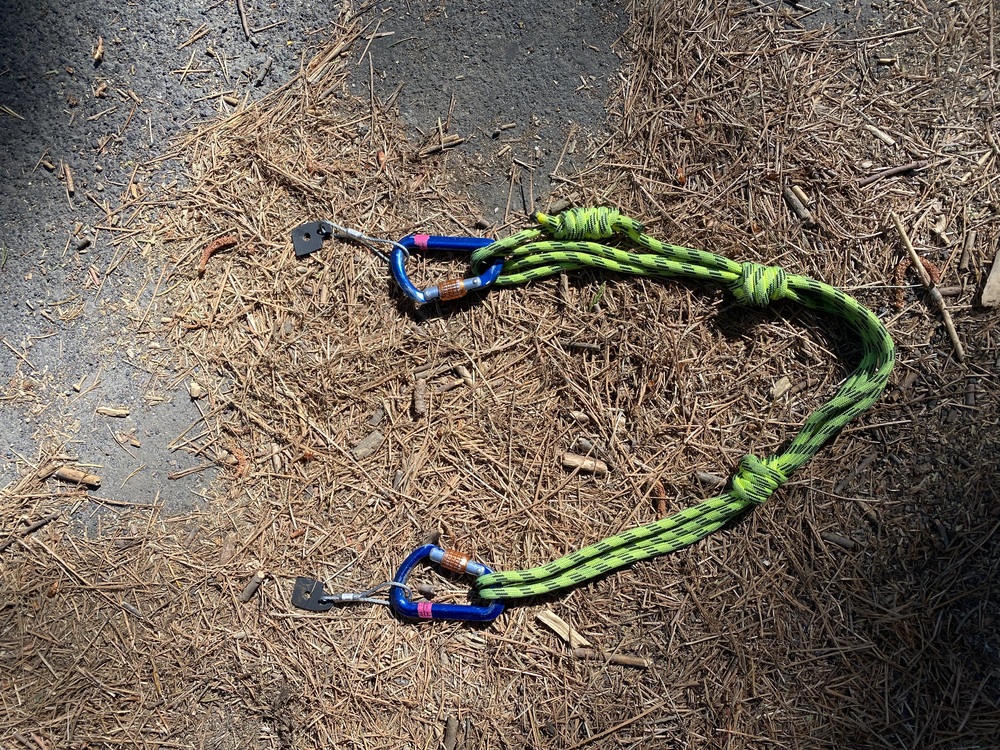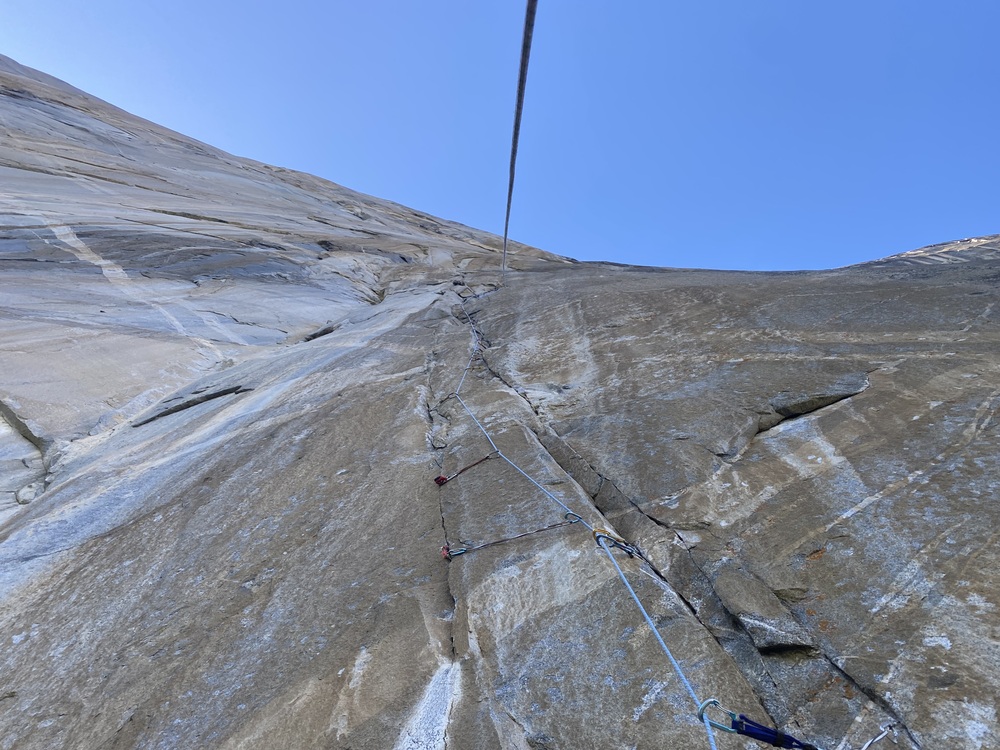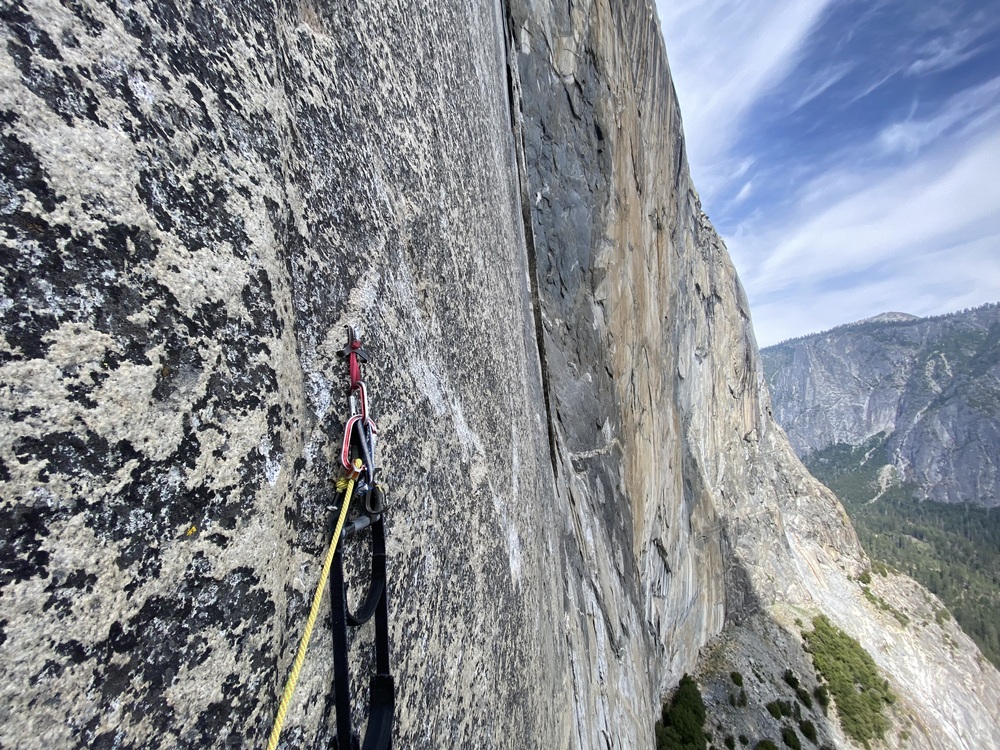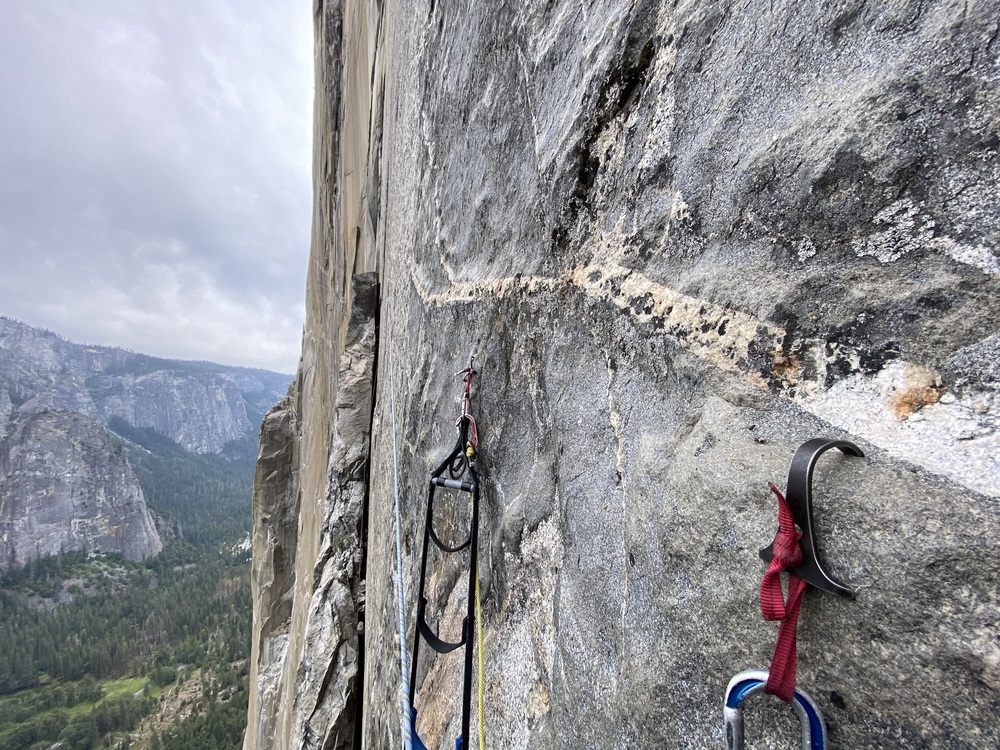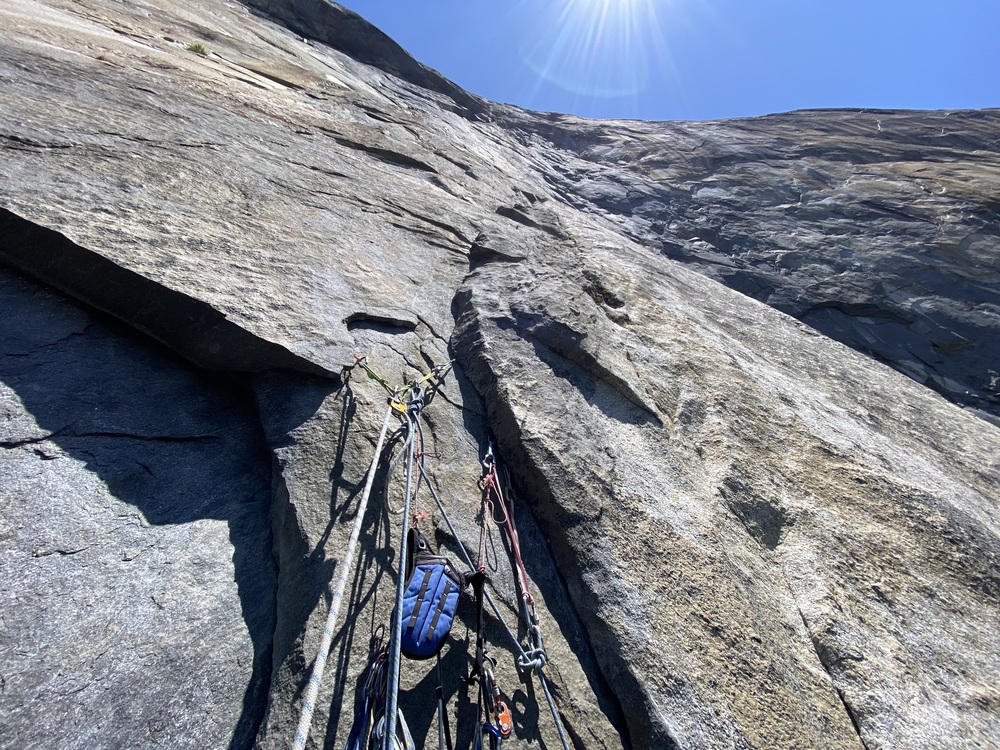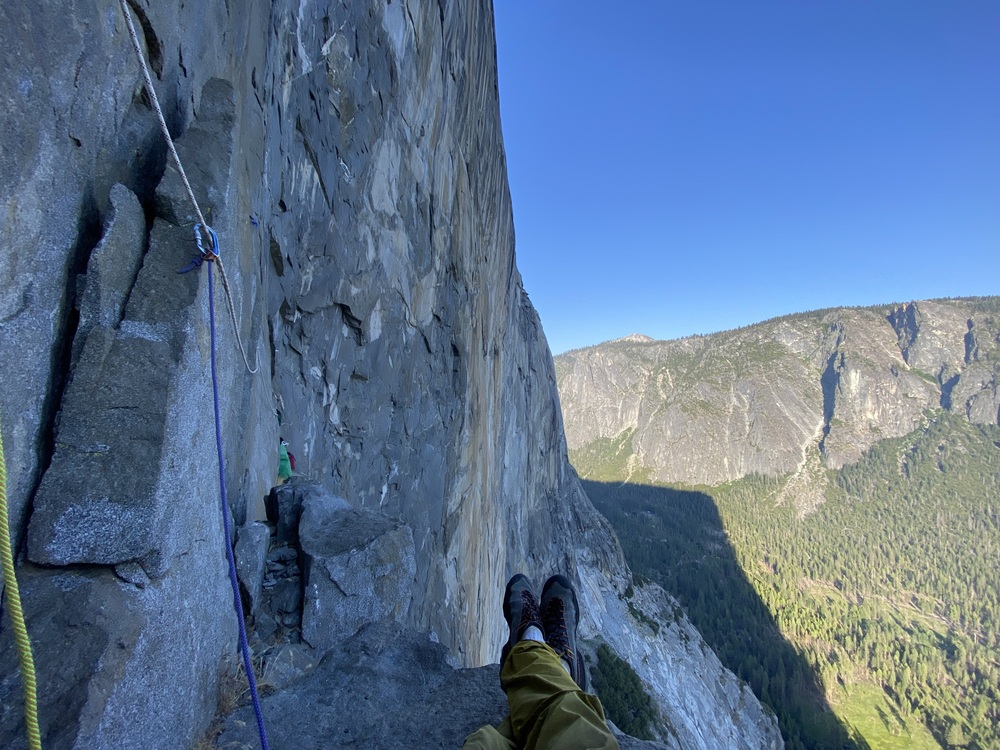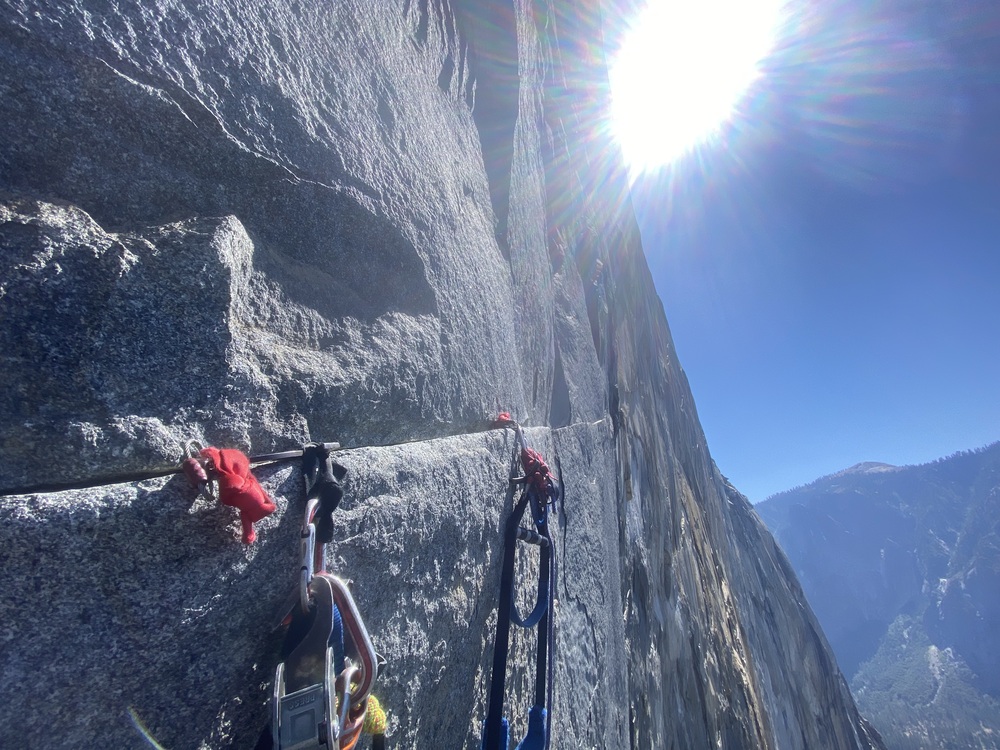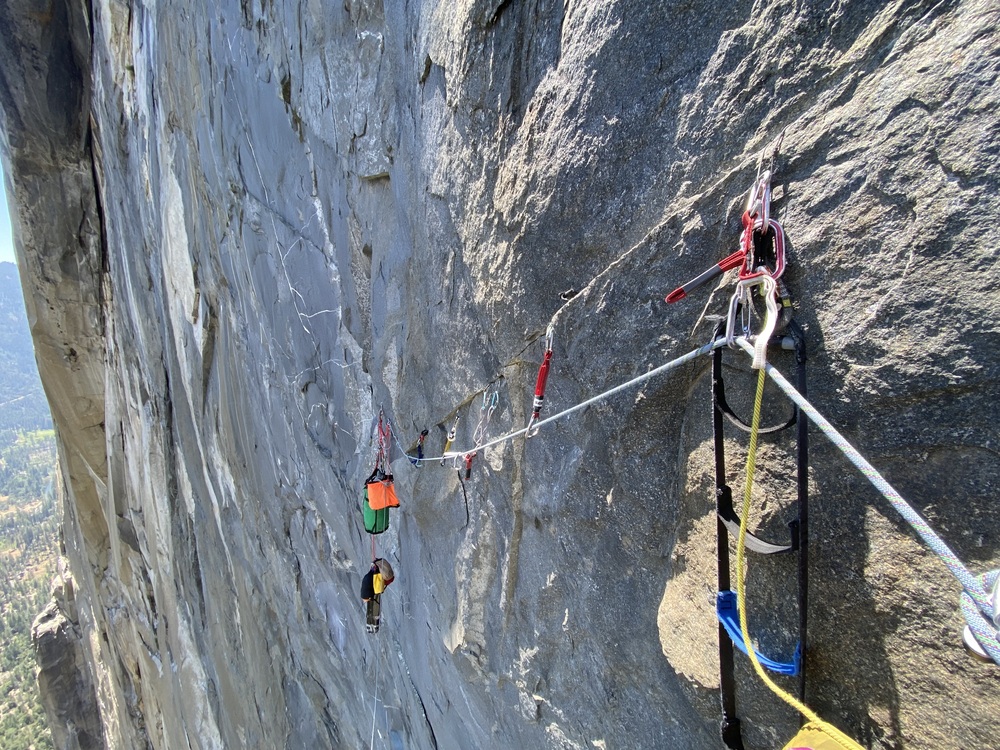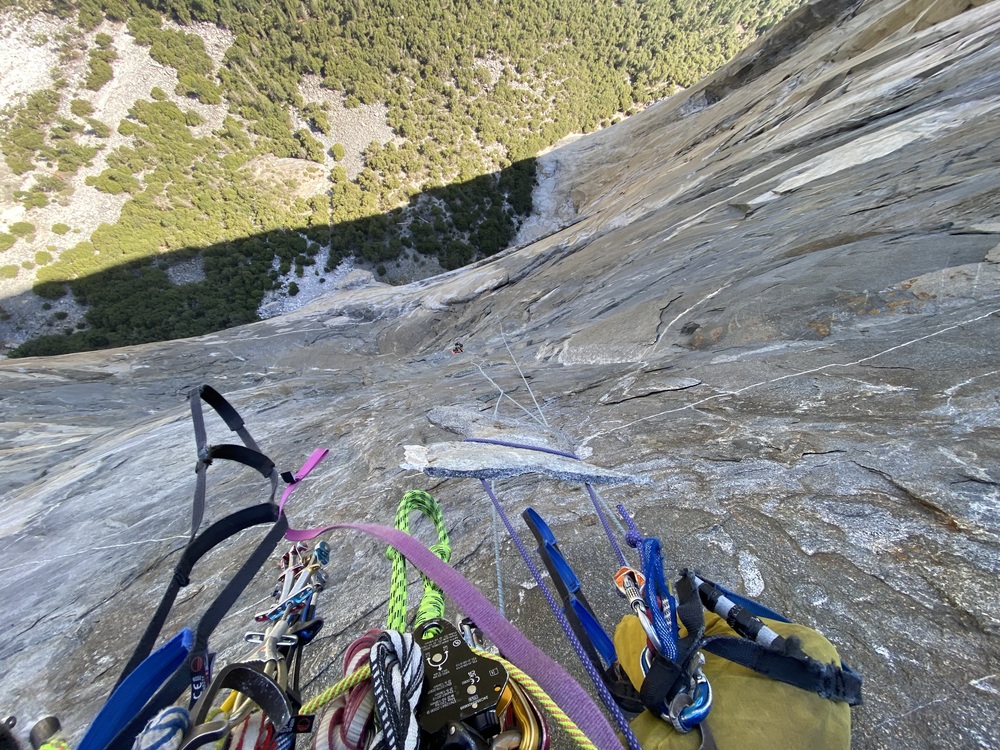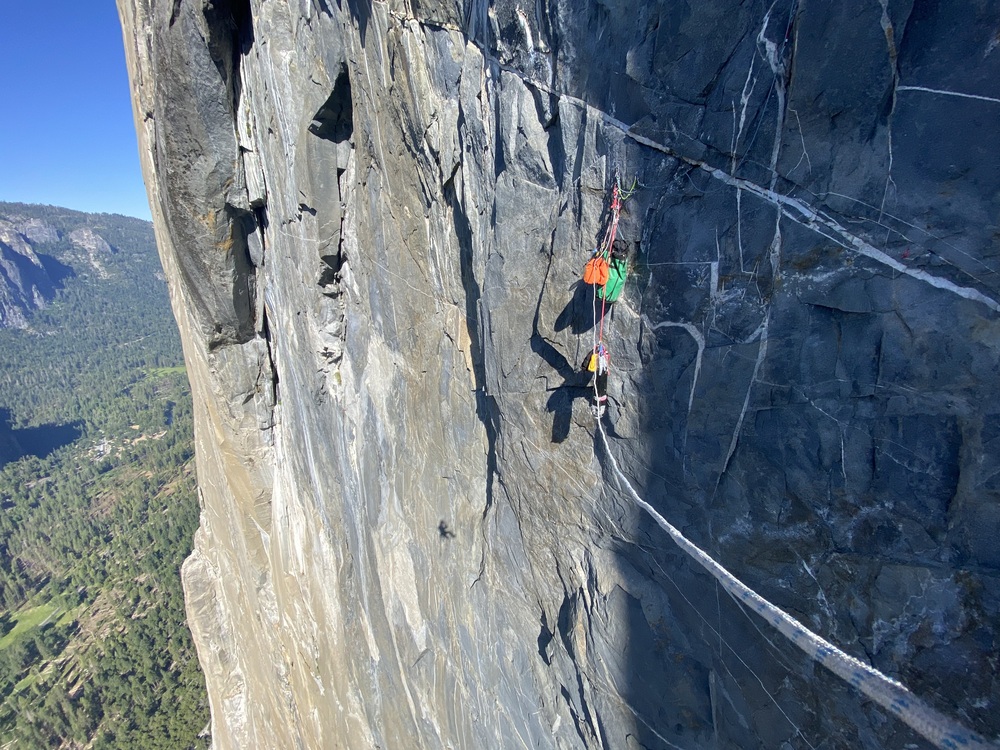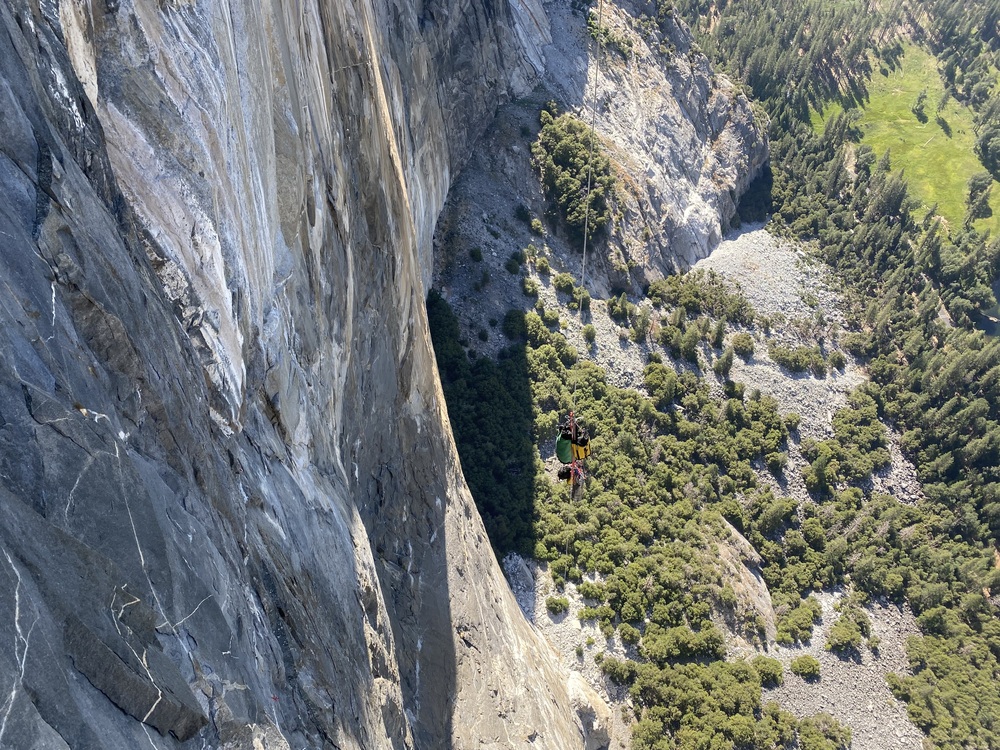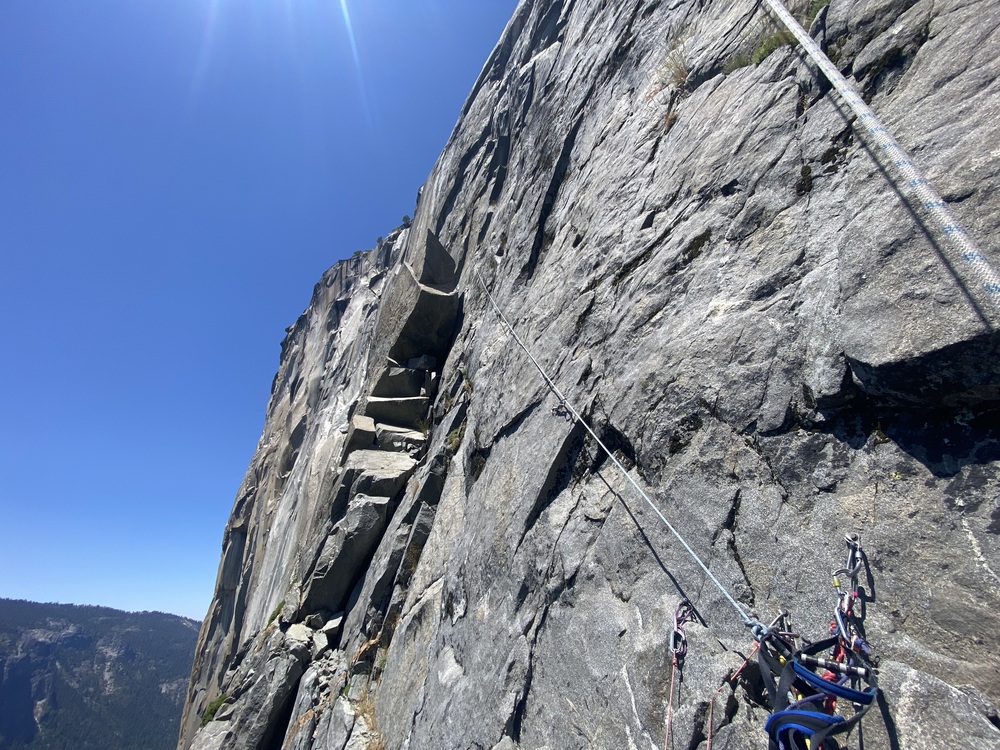Sea of Dreams Solo TR
|
|
Sorry for spamming this forum lately, this is the last one for the season, I promise. I’m normally pretty good at not responding to peer pressure… But when you have the guy who wrote the book that taught you how to bigwall and another legend of Yosemite climbing heckling you to solo the Sea, it’s pretty hard to say no. There’s many Sea themed routes in Yosemite. South Seas on El Cap, Arctic Sea on Half Dome, North Sea on Higher Cathedral, but there’s only one The Sea. I was initially put off by the loose sounding diorite, having previously found diorite pitches much more full on than others despite their grades. I hit the Black Tower on Zodiac on rope stretch on my second time climbing El Cap, and found the climbing on the 5th pitch of Zenyatta very full value and scarily loose. If these routes were tricky for me then the diorite pitches on the Sea would be absurd I thought. I’d also assumed that it suffered from what a few historic routes do, in that the history of the route makes it “classic” rather than the quality of the climbing. But, climbing with Paul Gagner, he convinced me of the quality of the route, saying it was one of his top 3 on the whole cliff. I was also reminded of the amazing history of the route, with perhaps the most infamous aid pitch in Hook or Book, and features like the RURP belay and the Expanding anchor. Looking at the topo, I was psyched so asked Ryan if he was keen to do it instead of Tempest. After asking though I immediately regretted it. There were too many pitches on it that I wanted to lead that doing it with a partner didn’t seem right. He was put off by the online horror stories of loose rock and pitches ready to fall off, so Paul told me to solo it. I didn’t need to be told twice. Day 1: It had been 4 days since I topped out the Reticent, and my lack of vehicle or campsite meant that I was keen to stash all my wall gear at the base of a route rather than in a public bearbox. I hadn’t fully committed to the idea of the Sea, but thought it was as good a route as any to slowly shuttle gear from the top to the base of. By the time I was ready to go again I had kind of committed to the idea of doing it without realising. The first pitch had loads of heads off the ground, which made me wish I put more effort into my rickety upwards pointing belay I had quickly made on the ground. A fair few heads’ cables snapped which was surprising given how many people had done the pitch recently, and was a little disconcerting. Pitch two was more of the same, and I think I was still recovering mentally from the Reticent as I was very nervous climbing it. It was a cool steepening crack with lots of heads (lots of which are probably unnecessary) and some good gear between. The third pitch was pretty cool and I was beginning to relax a bit more. The topo in the guide didn’t particularly match what I saw on the rock, and after a pendulum and some run out hooking and easy free climbing I reached some bolts. There were also some bolts to the side, and I wasn’t sure I was at the right ones, but I fixed to the ground from there either way. The next day I borrowed a scope from the Ask a Climber rangers to confirm I was in the right place, but trying to find the line of the rest of the route was really tricky! I remember reading somewhere that Bridwell said he couldn’t see the line of it from the ground after he had done the route and I could see why, it seemed an absolute mastery of route finding. Day 2: My friends had arrived from the UK the day before, so after my fixing day I had a rest day and got battered with them in the meadow when they arrived. Despite this I managed to get to the lodge in reasonable time to repeat my ritual of not so subtly filling up a gallon jug with Powerade for the wall. After the night before I was really unprepared, having spent the evening drinking rather than shopping for food for the wall, so I went to the village store afterwards to load up on tinned spaghetti hoops and meatballs, pork scratchings, apple pies, cinnamon rolls, instant noodles, and beer (and not much else). I always enjoy the worried look on the cashiers face when I unload all this crap onto the counter and wonder if they want to ask if I’m alright. After that and a slow hike up to the base, and an even slower repacking of the bag, and an even slower jumar to the top of my lines, and an even slower haul, I was ready to get climbing! The topo again was not as accurate as I was used to for the other routes I’d done. I wasn’t unhappy about this since it just added to the adventure of finding your own way with clues from the topo and the rock (and with some fixed gear so you never go too far astray), rather than having the route completely blueprinted for you. Having looked at this pitch through the scopes too it gave me a better idea of where to go. The initial circuitous climbing led to a steep crack with more heads in it. I sketched my way up this to the base of the Laura Scudders, where I saw a fixed blue totem. I normally pride myself in being pretty good at getting cams out, so I prepared myself for battle to booty the totem. If it came out any easier it would have fallen out. I’m not sure what that says about the expansion and contraction of the flake at different times and temperatures of the day, but I didn’t mind it for the free gear! The traverse itself was pretty cool. Very easy C1 in the thin expanding flake brought me to a bolt and a cool penji. I find pendulums one of the most objectively fun parts of aid climbing, and this one was no exception. A big swing to a slanting hook that I pulled on sideways to clip a rivet. After this was a couple aid moves then some easy 5.7 walking that I sketched across in very poor style in my approach shoes and aid rack pulling on loads of gear as I went. There was a nice stance there, and I was planning to link the next two pitches but I couldn’t be bothered to do it then and fix so I just set up my ledge and chilled early. Day 3: The Groovy Arch pitch zig zagged a lot and I couldn’t backclean as much as I wanted to, so didn’t really have the gear to link it into the next pitch like I had planned. This wasn’t too bad since I saw I could link the next two instead. I did the hook variation at the end of the arch, which made a lot more sense to me as it was one or two hook moves from cams to rivets rather than having to penji. I successfully linked pitches 7 and 8 together, and the fun of the swing on P8 has made me forget a lot about P7. I had been warned about tricky free climbing onto the continental shelf, so brought my free shoes in the bottom of my bag but was blindly confident that I wouldn’t need them. The pendulum isn’t very big, but goes to a ledge about level to the right with the rivet you’re swinging off, so you really need to get a good swing going. After some initial non-committal attempts, I really went for it and just about caught a jug on the ledge one handed at the very crest of my swing. I then, whilst one arming the jug, got a hook off my harness and managed to get it on a nubin on the ledge. That was the extent of the mandatory free climbing, as I aided across the ledge to the continental shelf (with some scrambling to the belay). I was surprised with how nice the Continental Shelf was as a bivvy, so decided to sleep there. It was still early yet though so, after the rare occurrence of actually eating lunch on the wall, I set about linking and fixing the next two pitches, the second being the notorious Hook or Book. In my mind the two most famous and classic hard routes on El Cap are The Sea and the Reticent, and the two most famous and classic hard pitches on them are Hook or Book and the Natural. I had seen the SAR guys do Hook or Book from across the SE face when I was on Zenyatta earlier in the season and was really inspired and psyched for it. Before going up, people in the meadow would ask me if I was going to do another wall and I would say “I don’t really know, I’m really tired” but then after a beer or two I’d look up at that distinct mottled rock above the Continental Shelf and start chanting “hook or book, hook or book!” Given I was the only climber on the SE face, I knew the “Ask a Climber” scopes in the meadow would be on me, and I considered whether or not it would be a good idea to lead the pitch with the tourists watching. I settled on it being better for a rescue for me if things went pear shaped that it would be distressing for them. I didn’t bring any cams bigger than a #5, so the short 5.9 offwidth section on the pitch before worried me a little, however I easily bypassed this with a cam placement just to the side, which I think was the only piece of gear I placed on the pitch. I then started the protected hooking between fixed pins, which wasn’t entirely straightforward, but eventually found myself at the pendulum rivet. I was incredibly lucky to have my rope come tight then, as I had forgotten to clip the end of my lead line to the top of the haul line and instead clipped it to the anchor, halving the amount of rope I could use. As it was I could abseil straight back down to the belay to sort it, and not even have to jug all the way back up since I was going to lower off for the pendulum anyway. Had this have happened into the hooking section I think the only thing I could have done would be to reverse all the climbing I’d done from the rivet (including the pendulum!) and then do the same thing, which would have been a massive pain in the arse. |
|
|
When I got back up and underway the pitch was really cool. It was pretty tricky to spot where you’re even swinging to, and once you’re there you can never see more than one hook placement ahead so it feels like you’re questing into nothing. Eventually I got to the nest of heads and was happy to see that the two crappy ones left in were able to hold the weight of the third that had fallen out. I clipped them but didn’t use them to progress and couldn’t be bothered to spend ages replacing them. The hook placements, whilst positive, weren’t as sinker as I thought they’d be, and you’d 100% hit the ledge from near the end unless you tied loads of hooks down or the heads miraculously held. Towards the end of the pitch I began to have intrusive thoughts about victory whipping from the belay to startle the tourists watching through the scopes, but it wasn’t difficult to dismiss these. After I finished I was pretty pleased and abed back to the ledge for a well earned kip. Day 4: The day started slowly with cleaning and hauling the pitches from the previous day. Not for the last time on the route I had placed a rivet hanger on a rivet and had a big runout to the next gear. I did what I assume others have done to avoid leaving gear by lowering off the wire rivet hanger then flicking it off with the rope after, which worked pretty well. P11 was mainly heads, rivets and hooks so I had more than enough rope and gear to link it into P12, which was fairly similar up to the expanding anchor. It was funny to see how it was actually visibly expanding as you bounced on the cams, but there were independent cracks to place them and they didn’t expand that much, so I felt fine on it. I had also learned my lesson from the first pitch and took my time to be happy that it would hold an upward pull for the next pitch, Don’t Skate Mate. The current guide makes this the A4+ crux, and I’d heard the horror stories of severed fingers and loose expando rock, but I didn’t find it too bad at all. There was a lot of decent gear and not much sketchy rock, and the hooking was comparatively easy to hook or book. The 5.9 offwidth worried me slightly as I used my #3 in the belay and left my #5 in my bag, so was armed only with a single #2 and #4. I thought I might have to free it, or go back for the #5, but managed to bodge it by hooking good flakes and doing some easy mantling to the right side of the crack. The Big Sur was really nice, and I had enough time to fix the Peregrine Pillar which was also a lot less loose and deathy and much more C1 than I had heard, and the aid above the pillar wasn’t too bad either. It does look as if it’s all about to teeter off from the ledge to be fair. I got back to the ledge and drank my allotted beer for every two pitches that I led that day, which was a good method for motivating me to climb quickly!Day 5: The Blue Room was another pitch that has a lot written about it online. I’d heard people saying the whole feature is ready to come off, so I wasn’t keen on the gear belay below it. Luckily it was really easy to link the To the Tooth pitch with The Blue Room. My experience of it was that it was completely fine, and that a climber, even putting cams behind it, is so insignificant compared to the massive weight of the rock that would come off that the risk you’re exposing yourself to by climbing it is similar to the avalanche risk that most happily accept alpine climbing. Maybe that’s my way of justifying it to myself, but I personally never saw any sign that it was even loose. The horizontal offset beak seam on that pitch was utterly spectacular as well. I left this going upwards at the right point, but kept going up the corner missing the rivet and fixed head going right to the belay. I probably got a taste for what the Sea used to be like up there, with lots of hooking suspect flakes off the route, but when I could see this ended I realised I was lost, and saw the belay 10ft to the right. Some quick down aiding brought me to the right place, and I made it to the RURP belay. A large part of the reason I was keen to get on the route was that it had been done a couple times recently, so there was some up to date beta and the fixed gear had been tested. The SAR guys who had raced up it at the start of the season had perhaps pre-rescued me by telling me that a block just off the RURP belay on The Ace in Space pitch moved when they took a beak out from under it. Which block it was was fairly obvious, and knowing it was loose I could fairly easily skip that placement for the next solid one, which was really nice. It was also nice to know that the SAR guys had a good knowledge of the route in case I did need a rescue! The traverse off that belay after the block was also phenomenal, and had some engaging hooking above it. Again, with no rope drag, it was a fairly easy link into the Bull Dyke, which again made the hauling more straight up. I’d not really seen the Bull Dyke before from other routes, but it’s a beautiful feature that goes for hundreds of feet either side of the section you climb, and is unlike a lot of the other geology I’ve experienced on El Cap so far. The climbing was also fairly challenging and engaging to find the right placements. At one point I saw a big v notch in a flake which seemed a nice easy obvious hook placement. It held a downwards bounce in my ladders, so I committed to it, unclipping myself from the good offset I had just placed, though leaving it for pro after a moderate runout to some heads. As I stood in my ladders and slowly reached towards the fixed head, my hand stayed in the same place as I slowly moved backwards. I realised that the flake was peeling off, so made more of a lunge for the head, which only made the flake come off faster and keep my hand the same distance from salvation. I, along with the flake, came away from the rock and took a mostly rope stretch fall onto the good piece to my side. I wasn’t too worried about the flake cutting my ropes as the pitch was steep enough that it wouldn’t have gone near them, and I had also already traversed just beyond the lower belay, so it was a clean fall zone for it. I was however confused when I didn’t see it falling. It had got caught in the loop that my lanyard and alfifi created and was suspended from my harness. I obviously immediately did the classic young person thing of getting my phone out and posting it on social media. I really appreciate the ability to immediately spray to everyone you know about how rad and death defying you are in real time, and don’t even have to wait until you get down to the meadow. After that I lifted the flake off my lanyard and lobbed it as far from my ropes as possible. It still hit the continental shelf and shattered. Luckily no one had been climbing on the South East face for days, so I was fairly confident it wouldn’t hit anyone. After that I was slightly more cautious with the hooks I placed on any flake that looked suspect, as on another pitch it could have been a lot worse. Even though it was only 4pm when I finished leading, the mental stress was starting to build up so I finished early for the day. Day 6: I’d heard that the Price is Light variation had partly fallen off, and the topo didn’t seem to match the rock very well, but some new looking fixed head showed me where to start, and the correct way revealed itself as I went. The next A4 pitch was really straightforward, until I got to the final rivet and was faced with a big flake I could move with my hands that the topo seemed to suggest I needed to climb. I couldn’t find anything bypassing it for ages, and even resorted to lowering down and looking left and right, before coming back up and eventually finding the tiny bathook that I had missed before. I thought the Peruvian Flakes pitch immediately after had much bigger fall potential than the previous A4 one, with long stretches of hooking and dodgy gear and required some composure, though ultimately wasn’t that bad either. By this stage in the day the combined stress of all the leading and fairly involved cleaning had started to weigh on me, and I felt I climbed P22 with just my lizard brain engaged. I’m not sure if it was some weird flow state, but I didn’t feel like I was making any conscious decisions, I had led enough aid pitches that season by this stage that I could just look at the rock and make a simple decision between whether to place a cam, beak, hook or clip a head, and that was all there was to it. I moved up the pitch pretty quickly, and was beyond the point of worrying about a fall so became pretty blasé about testing or whether gear was placed perfectly if it did hold a couple quick bounces. This felt quite cool to be doing on some not so easy terrain, but I guess can easily result in some big whips. Luckily I didn’t fall though. I only really returned to my normal self thinking about things other than what task I should do next after a little time chilling on the ledge. I think that’s the thing about soloing, is that there’s no one else to do anything, so if you can always be doing something and if you aren’t then you aren’t progressing. I think that’s makes it easier to not have any breaks and just get fully into the groove of the wall, which I enjoy but also weighs on you over time |
|
|
Day 7: Tricky route finding and the wall literally crawling with silverfish made P23 all a bit more involved than I would have liked. After some obvious initial moves I was scratching around with hooks trying to look for any fixed gear or pin scars to mark my way, I eventually figured it out and made it to the 5.7 free climbing, which was horrendous in the still morning heat with a full aid rack, my ladders getting caught and grigri not feeding. I botched my way up to the belay. Looking at the next pitch to the Igloo and the pitch above it, I thought I’d have to do a nasty haul up the side of it either way, which I wasn’t excited for but thought it would be better to haul from the Igloo so I wouldn’t have to go down as far to free the bags as opposed to if I linked the pitches. With that in mind I didn’t adjust where the microtraxion was on the bags on the haul line as it was a short pitch, and just took two of each size cam and nothing else. I ended up clipping a bolt off the belay and then nothing else the whole pitch, bypassing the really awkward looking chimney by going all the way around the other side of the top Igloo block. When I got to the top of the pitch I realised the hauling looked atrocious, and that the next pitch actually finished right above the previous belay. I decided to try to link the pitches, though it might mean going back down to get more gear or the give myself more haul line. Somehow I managed to be really jammy and make it to the belay just as the haul line came tight and as I ran out of cams, though I could have hauled on the 20ft of spare lead line and passed the knot, so I had some leeway. The hauling from here was fine and I would recommend doing this to anyone in the future. I was keen to get down for a meat and beer supper in camp 4 with my friends from the UK, so charged up the next pitch intent on linking it to the top. I had no massive moral qualms about tapping a couple beaks into the potential C4 pitch, as an early experience in trying to climb clean at all costs led me to hit the Black Tower on Zodiac on rope stretch. It did feel slightly like taking the easy way out having just done a hard route, but climbing C4 instead of A2 feels a bit like designer danger to me, like doing a hard aid pitch with a toprope available to bail onto. Each to their own though, I do have great respect for people who climb clean but I get too scared for it. After this section there was a classic top-of-el-cap low angle aid section. I’ll never not feel stupid inching my way up a 45 degree ramp that you could probably just walk up in good shoes, but at least it was C1 and went quickly. Linking it into the final scramble pitch was pretty straightforward too, though the top slab felt sketchy in approach shoes. Linking these two pitches also worked well for me in terms of the hauling, the bags got stuck once coming over the lip but apart from that it was fine. I quickly sorted out my bags on the top, separating the food, rubbish and shit that I couldn’t leave on the top from the stuff I could, and ran down the east ledges to discover my friends had not got any meat from the shop, though there was plenty of beer! I’m really happy I decided to try the Sea, and can’t thank Paul and Andy enough for encouraging me to do it. It was so much better than I thought it would be, probably up there with Tempest as the best two routes I’ve done. A lot of the scary horror stories online about it I didn’t experience, and it turned out to be only loose off the route (with the exception of the block off the RURP belay). It seems like lots of trip reports get written when people find a route hard or scary, which leads to a bias in reporting about it as the people who find it pretty casual don’t feel the need. Hopefully this one changes that! I think the Sea’s current state of looseness is really fun, making the climbing more engaging even when it’s “easy”, but if you do cock up and rip a flake off it probably won’t hit your ropes or belayer since the diorite pitches are mostly pretty steep and traversing. I actually probably found the 5th pitch on Zenyatta to be looser than any of the climbing on the Sea, and with the exception of Hook or Book, the Sea isn’t a massive step up in terms of difficulty. For anyone umming and ahing about getting on it, I would recommend it and if all goes to shit you can always bail onto the NA at a few points. |
|
|
Nice work Olly! Olly Tippettwrote: I remember watching this from above! |
|
|
Don't apologize, dude. Keep at it |
|
|
Way to send! Are you tired yet? I did Reticent in 98 and the Sea in 01. A quarter century later, which do you reckon is harder, and why? Cheers to a bitchin' season, mate. |
|
|
They’re probably about the same overall difficulty. Reticent is currently much harder to get up in terms of how tricky the placements are but is probably safer, whilst The Sea is more straightforward but I’d say is more dangerous. If you’re going by NW ratings then I’d say Hook or Book is the only A4 pitch on either. |
|
|
Ignorant Sport climber here with an Aid question: What are the "heads" the OP talks about clipping? quote below for reference. Thanks in advance for an explanation! " I’m not sure if it was some weird flow state, but I didn’t feel like I was making any conscious decisions, I had led enough aid pitches that season by this stage that I could just look at the rock and make a simple decision between whether to place a cam, beak, hook or clip a head, and that was all there was to it." |
|
|
TThurmanwrote: |
|
|
Thank you Marc. I knew of copperheads, but it didn’t occur to me that they were left behind and subsequent climbers would utilize them. I appreciate the explanation. |
|
|
Great read Olly; I wish you the best my friend; and good luck |
|
|
It was fun to read your trip report, Olly. Good job on The Sea! Me and my buddy Chad exchanged a few hellos with you at the base while we were walking to Zodiac and were stoked for you. |
|
|
Awesome! |
|
|
Congratulations, Olly! Very impressive send. As Nick mentioned, it was cool chatting with you as you were roping up for SoD. Love your TRs and photos – please keep them coming! |
|
|
Great read. Well done. And amazing climbing as well. |
|
|
Cool stuff!! Start glassing and find a new line, sounds like you’re ready!!! |
|
|
Thanks for your videos Olly, not joking, it was inspiring. Helmet cam footage of hard aid is a long way from the most popular or viral climbing videos these days - but I found it engrossing. I have done one pitch of moderate aid in my life (involving a small pendulum and couple of hook moves off an enormous and bomber bolt) so I have a tiny taste of what the "hook or book" pitch must involve and my heart was in my mouth for most of that. Fuck me, that mixup with your lead rope being tied off...the thought of running out of rope while strung out on aid hooks...fark that's gunna give me nightmares. Imagine having to downclimb/reverse those moves haha. |
|
|
Olly hasn't cross-posted his YouTube videos here but they are well worth a look. I'm not usually a fan of headcam climbing films but I found these compelling. Hook or Book |
|
|
Nice TR. It's interesting how the route has changed over time. |

 Continue with onX Maps
Continue with onX Maps Sign in with Facebook
Sign in with Facebook
















